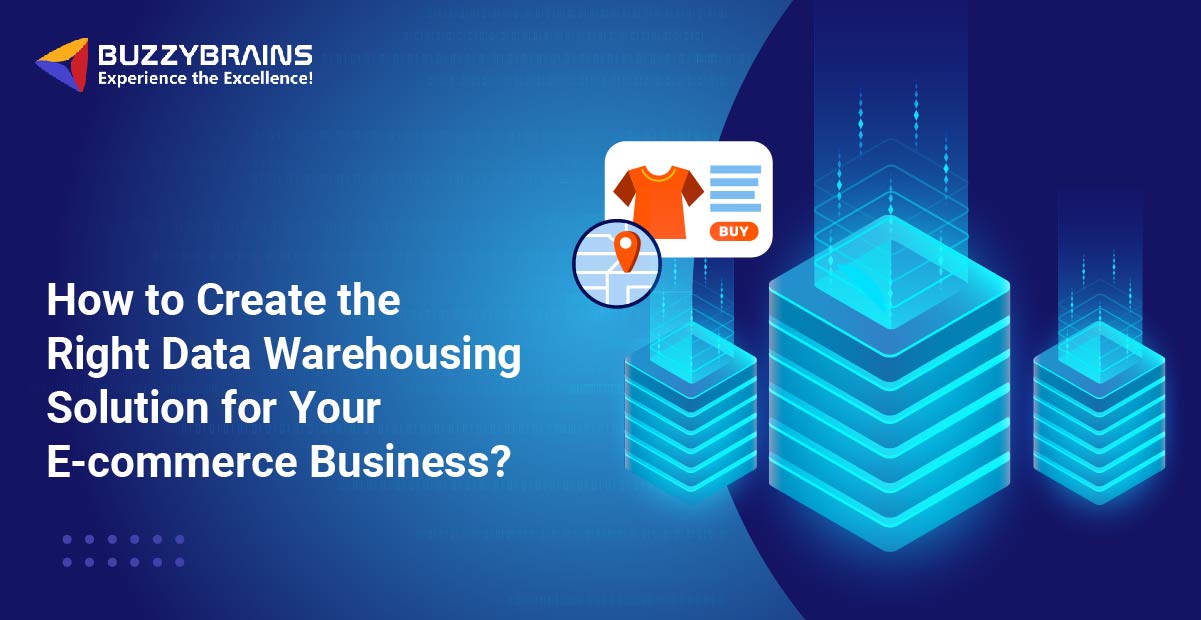How to Create the Right Data Warehousing Solution for Your E-commerce Business?

The e-commerce landscape is evolving rapidly, and data is at the heart of this transformation. E-commerce businesses generate vast amounts of data daily—from customer interactions, product sales, marketing campaigns, and inventory management. To harness the power of this data, businesses need an efficient system to collect, organize, and analyze it. This is where data warehousing comes in. A well-structured data warehousing solution can give your e-commerce business a competitive edge by offering actionable insights for better decision-making.
In this blog post, we will explore how to create the right data warehousing solution tailored to your e-commerce business needs.
- Data Warehousing for E-commerce
- Benefits of Data Warehousing for E-commerce
- Different Components of Data Warehousing
- Key Considerations Before Building an E-commerce Data Warehousing Solution
- How to Create the Right Data Warehousing Solution for Your E-commerce Business?
- Step 2: Choose the Right Architecture
- Data Warehousing for E-commerce ROI: Various Costs Involved
- Best Practices for E-commerce Data Warehousing
- Common Challenges in E-commerce Data Warehousing and Their Solutions
- Real-World Applications of Data Warehousing for E-commerce
- FAQs About Data Warehousing for E-commerce
- Conclusion
- Transform Your E-commerce Data Management with BuzzyBrains’ Expertise!
Data Warehousing for E-commerce
Data warehousing is the process of collecting and managing large volumes of structured and unstructured data from multiple sources in a centralized system. For e-commerce, this means gathering data from sales, customer interactions, website traffic, marketing campaigns, and more into a single platform where it can be easily accessed and analyzed.
E-commerce businesses use data warehouses to store historical data that helps them analyze trends, optimize operations, and personalize customer experiences. Instead of managing multiple databases, data warehousing consolidates everything into one system, making data retrieval and analytics much more efficient.
Related Blog: What is Data Warehousing: A Detailed Introduction to Data Warehousing
Benefits of Data Warehousing for E-commerce
Data warehousing provides numerous benefits to e-commerce businesses, helping them streamline operations, improve customer experiences, and boost profitability. Here are the key advantages:
- Centralized Data Management: All your data from different platforms (e.g., CRM, ERP, and website analytics) is stored in one place, making it easier to manage and access.
- Improved Decision-Making: With historical and real-time data at your fingertips, you can make more informed business decisions based on data insights.
- Enhanced Customer Personalization: Analyze customer behavior, purchase patterns, and preferences to deliver personalized marketing campaigns and product recommendations.
- Better Reporting and Analytics: Gain actionable insights with advanced analytics and reporting tools that are integrated into the data warehouse.
- Real-Time Inventory Management: Keep track of stock levels across multiple locations and channels, ensuring efficient inventory management.
- Increased Operational Efficiency: Automate data processing and integration tasks, reducing manual effort and the chance of human error.
- Scalability: Data warehouses are built to grow with your business, handling increasing volumes of data and more complex queries as your operations expand.
Different Components of Data Warehousing
A data warehouse is made up of several components that work together to store, process, and analyze data. Understanding these components will help you design the right solution for your e-commerce business:
- Data Sources: All the systems where your data originates (e.g., CRM, ERP, transactional databases, third-party apps).
- ETL (Extract, Transform, Load) Tools: These tools extract data from different sources, transform it into the correct format, and load it into the warehouse.
- Staging Area: A temporary storage area where raw data is processed before it’s moved into the data warehouse.
- Data Storage: The core storage component of the data warehouse where all your historical and real-time data is stored.
- Metadata: Information that describes your data, making it easier to locate and use.
- Query and Reporting Tools: These tools help users access and analyze the data stored in the warehouse, enabling them to generate reports and insights.
- Data Marts: Subsets of the data warehouse tailored for specific departments or business units.
Key Considerations Before Building an E-commerce Data Warehousing Solution
Before you begin building a data warehouse for your e-commerce business, there are several key factors you should consider:
- Data Volume: Estimate the amount of data your business generates and plan for future growth.
- Data Sources: Identify all the data sources (e.g., website analytics, CRM, ERP) that need to be integrated into the warehouse.
- Data Integration: Choose the right ETL tools to ensure smooth integration of data from multiple platforms.
- Scalability: Ensure your data warehouse can grow as your business expands, accommodating more data and users.
- Data Security and Compliance: Implement security measures to protect sensitive data and ensure compliance with regulations like GDPR and PCI-DSS.
- Performance: Consider the performance of your queries, especially if your business handles large datasets and complex queries.
- Budget: Allocate a budget that covers setup, ongoing maintenance, and any additional tools needed.
Related Blog: Building a Scalable Data Warehouse: 10 Essential Factors and Key Data Warehousing Techniques to Consider
How to Create the Right Data Warehousing Solution for Your E-commerce Business?
Building the right data warehousing solution involves several key steps. Here’s a step-by-step guide to help you create a solution tailored to your e-commerce needs:
Step 1: Define Your Business Requirements
The first step is to clearly define your business requirements. What are the key metrics you want to track? Do you need real-time or historical data? Understanding your business goals will help you define the data you need to collect and the insights you want to derive.
Step 2: Choose the Right Architecture
Next, choose the architecture for your data warehouse. There are three primary options: on-premises, cloud-based, and hybrid. Cloud-based solutions like Amazon Redshift, Google BigQuery, and Snowflake are popular choices for e-commerce businesses due to their scalability and cost-effectiveness. On-premises solutions may be more suitable for businesses with specific security or compliance needs.
Step 3: Select a Data Warehousing Platform
Once you’ve chosen your architecture, select a platform that aligns with your business needs. For example, Amazon Redshift offers seamless integration with AWS services, while Google BigQuery provides powerful real-time analytics. Snowflake is known for its flexibility and ability to handle large datasets.
Step 4: Design Your Data Model and Schema
A well-designed data model and schema are crucial for optimizing the performance of your data warehouse. Choose between common schemas like the star schema or snowflake schema, depending on the complexity of your data. Organize your data in a way that allows for efficient querying and reporting.
Step 5: Implement ETL Processes
ETL (Extract, Transform, Load) processes are critical to ensuring data from different sources is accurately transferred into the data warehouse. Choose ETL tools like Apache Nifi or Talend, which allow you to automate the extraction, transformation, and loading of data.
Step 6: Test and Optimize the Data Warehouse
Once your data warehouse is set up, it’s essential to test it thoroughly. Ensure data accuracy, optimize query performance, and adjust as needed. Regular testing and optimization will ensure that your data warehouse continues to meet your business needs as it grows.
Data Warehousing for E-commerce ROI: Various Costs Involved
Creating and maintaining a data warehousing solution involves several costs. Here are some factors to consider when evaluating the ROI:
- Setup Costs: The initial investment required for infrastructure, software, and development.
- Maintenance Costs: Ongoing costs for updating and managing the data warehouse.
- Data Storage Costs: The cost of storing large volumes of data, especially for cloud-based solutions.
- ETL Tools: Licensing costs for ETL tools used to extract, transform, and load data.
- Analytics and Reporting Tools: Costs associated with the tools used for data visualization and analysis.
- Security and Compliance: Expenses related to implementing and maintaining data security measures.
Best Practices for E-commerce Data Warehousing
To ensure the success of your e-commerce data warehouse, follow these best practices:
- Regular Data Backups: Always back up your data to prevent data loss in case of system failures.
- Data Governance: Implement policies for data access, management, and security to ensure data quality and compliance.
- Use Analytics Tools: Integrate tools like Power BI, Tableau, or Looker for enhanced data visualization and insights.
- Optimize ETL Processes: Continuously monitor and optimize your ETL processes to ensure efficient data integration.
- Data Archiving: Archive older, less frequently accessed data to improve performance and reduce storage costs.
Common Challenges in E-commerce Data Warehousing and Their Solutions
E-commerce businesses often face challenges when implementing data warehousing solutions. Here are some common issues and their solutions:
- Handling Large Data Volumes: Use cloud-based storage solutions that scale with your data needs.
- Complex Data Integration: Employ automated ETL tools to ensure seamless integration of data from multiple sources.
- Query Performance Issues: Regularly index your data and optimize your queries to improve performance.
- Data Security Concerns: Implement encryption, role-based access control, and compliance monitoring to safeguard sensitive data.
- Data Accuracy and Consistency: Implement data quality checks and audits to ensure accurate and reliable data.
Real-World Applications of Data Warehousing for E-commerce
Data warehousing solutions are applied in various real-world e-commerce scenarios:
- Customer Segmentation: E-commerce businesses use data warehouses to analyze customer demographics and behavior for more effective segmentation and targeted marketing.
- Inventory Management: Data warehouses provide real-time insights into inventory levels, helping businesses manage stock across multiple locations and channels.
- Personalized Marketing Campaigns: Analyze customer purchase history and preferences to deliver personalized recommendations and targeted promotions.
- Sales Forecasting: Historical sales data stored in the warehouse helps businesses forecast future demand and plan inventory accordingly.
FAQs About Data Warehousing for E-commerce
Q1. How can a data warehouse improve reporting and analytics in e-commerce?
A data warehouse consolidates data from multiple sources, allowing businesses to generate comprehensive reports and gain valuable insights into their operations, sales trends, and customer behavior.
Q2. What data sources can be integrated into an e-commerce data warehouse?
You can integrate data from various sources such as CRM systems, ERP platforms, website analytics, payment gateways, social media, and third-party applications.
Q3. What are the key components of a successful e-commerce data warehouse?
A successful e-commerce data warehouse includes components like ETL tools, data storage, query and reporting tools, metadata management, and data marts for specific business units.
Q4. What tools can I use to integrate various data sources into my data warehouse?
Popular ETL tools for integrating data include Apache Nifi, Talend, and Microsoft SQL Server Integration Services (SSIS).
Q5. How do I ensure data quality and accuracy in my e-commerce data warehouse?
Implement data quality checks, validation rules, and regular audits to ensure that the data stored in your warehouse is accurate, consistent, and reliable.
Conclusion
Creating the right data warehousing solution for your e-commerce business is crucial for managing and leveraging the vast amount of data your business generates. From improving customer personalization to enhancing operational efficiency, a well-built data warehouse can transform your business. By following the steps and best practices outlined in this guide, you can design a data warehouse that meets your business’s current and future needs.
Transform Your E-commerce Data Management with BuzzyBrains’ Expertise!
At BuzzyBrains, we specialize in designing custom data warehousing solutions that help e-commerce businesses unlock the full potential of their data. Let us help you streamline your operations, improve decision-making, and boost your bottom line. Contact us today for a consultation and take the first step toward transforming your e-commerce data management.
